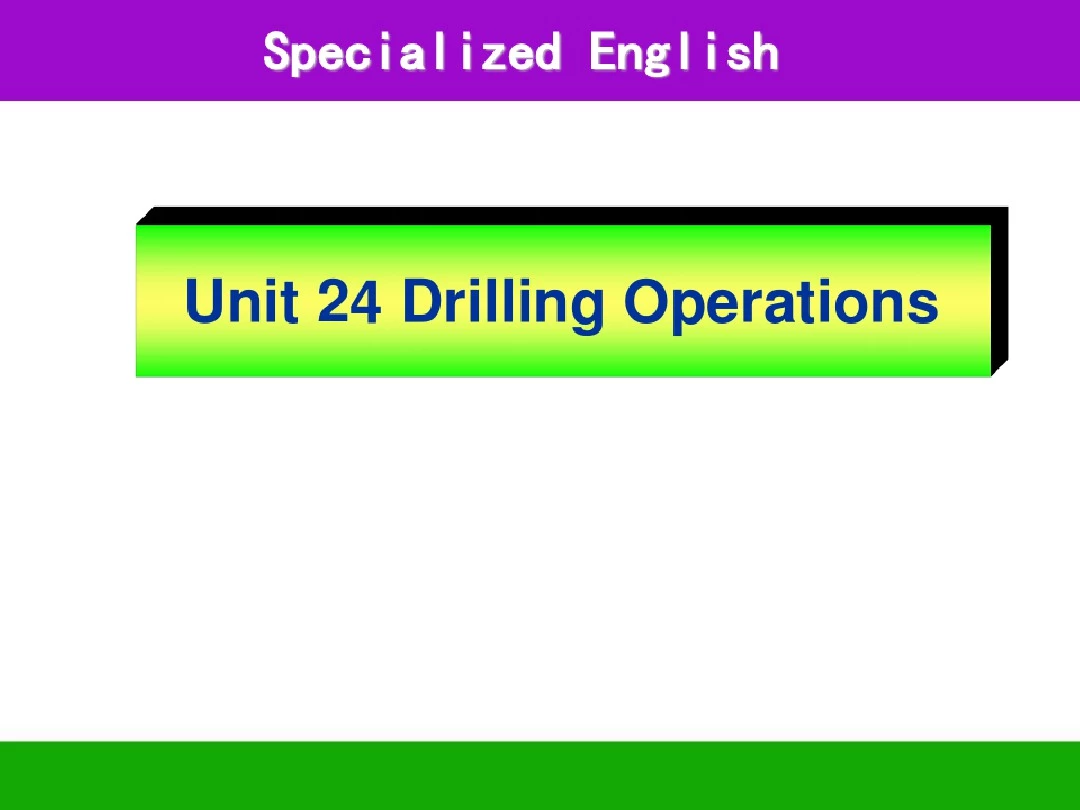

4机械工程专业英语第四课 翻译的基本方法–增词与减词 Skills of Translation –adding and reducing words 三、增词与减词 (一)增词译法:在对英文进行翻译时,若按字面翻译,句子的结构不完善,或句子的含义不明确,或词汇的概念不清晰时,需要增 加某些词语,以便更完善、清楚地表达英语句子的内容。例: Efficiency costs money, safety adds complexity, performance increases weight. 直译:效率花费金钱,安全增加复杂性,性能增加重量。 增词译法:对设备(或器件)来说,要提高效率就要增加成本,要想保证安全势必要增加其复杂程度,而要改善性能就要增加其重量。 1. 增加表示时态的概念的词 英语中表达时态的词往往是没有词义的,翻译时必须用一些中文词将其表达出来:Balloons were (and are) usually filled with hydrogen. 气球过去(和现在)一般都用氢气来充气。 翻译的基本方法–增词与减词 Skills of Translation –adding and reducing words We can learn what we did not know. 我们能够学会我们原来不懂的东西。(过去时) The generator set will start working tomorrow. 这台发电机组将于明天开始运行。(将来时) An object is said to possess kinetic energy if it if moving. 如果一个物体在运动,就可以说它有了动能。(进行时) We have learned how to fit the computer. 我们已经学会了怎样安装电脑。(完成时) Reamers are used to finish drilled holes. 绞刀用来将已经钻好了的孔进行精加工。(过去分词表示“完成”的状态) 翻译的基本方法–增词与减词 Skills of Translation –adding and reducing words 2. 补充原文省略的词 英语中常根据语法或语言习惯省略某些词语,如重复出现时,省去形容词修饰的名词,用do代替实义动词,在省略句中,省去连 词、主语、谓语动词或其它成分等: In figure 5, P is the resistance, S the distance and C the effort. 在图5中,P是阻力,S是距离,C是作用力。 All bodies consist of molecules and these of atoms. 所有物体均由分子组成,而分子由原子组成。(补译出these 后面省略的molecules consist) The changes in matter around us are of two types, physical andchemical. 我们周围的物质变化有两种,物理变化与化学变化。 When pure, water is a colorless liquid. 水纯时,水是无色的液体。
1.1 引言 从一般意义上讲,英语可分为两大类: 普通英语(Common/General/Ordinary English) 专业英语(English for Science and Technology) 专业英语是随着新学科的不断涌现和专业分工的日益细化,在科技英语的基础上逐步形成的,因此其专业色彩更加浓厚,涉及的面更加狭窄,与专业内容相互配合的更加密切。1.2 词汇特点 1.2.1 词汇的分类 1. 专业或技术词汇(special technical words).。技术词汇是指某个专业所特有的词汇。 2. 次技术词汇(special sub-technical words)。次技术词汇是指很多专业和学科所共有的词汇。 3. 非技术词汇(non-technical words)。非技术词汇是指在普通英语或非专业英语中使用较少,但实际却属于非专业英语的词汇。 1.2.2 词汇的构成 大部分专业词汇来自外来语是专业英语词汇构成的一个显著特征。 专业英语词汇构成的另外一个显著特征是广泛使用词缀(affix)和词根(etyma)。 以下是几种主要的构成方式: 1. 合成法(composition) 2. 转化法(conversion) 3. 派生法(derivation) 4. 缩略法(shortening) 5. 混合法(blending) 6. 字母外形法(letter symbolizing) 7. 人名法 1. 合成法(composition) 由相互独立的两个或更多的词合成得到新词的方法成为词汇的合成法。合成所得到的词汇叫做合成词或复合词。 合成法又可分成如下形式: (1) 名词+名词:构成名词性词组。例如: horse+power→horsepower 马力band+width→bandwidth 带宽 radio+broadcasting→radiobroadcasting 无线电广播 (2) 名词+形容词:构成形容性词组。例如: network+wide→network-wide 网络范围 electron+hungry→electron-hungry 缺少电子ice+cold→ice-cold 冰冷 (3) 名词+副词:构成形容词性词组,一般作定语。例如: feed+back→feedback 反馈check+up→checkup 检查 (4) 名词+过去分词:构成形容词性词组,一般作定语。例如: phase+locked→phaselocked 锁相computer+based→computerbased 基于计算机power+driven→powerdriven 电能驱动 (5) 名词+-ing:构成形容词性词组,一般作定语。例如: resistance+containing→resistance-containing 含电阻 direction+indicating→direction-indicating 方向指示time+varying→time-varying 时变(6) 形容词+名词:构成名词性或形容词性词组,一般作定语。例如: short+circuit→short-circuit 短路low+pass→low-pass 低通 (7) 形容词+形容词:构成形容词性词组,一般作定语。例如: dark+blue→dark-blue 深蓝red+hot→red-hot 炽热 (8) 形容词+-ing或过去分词:构成形容词性词组,一般作定语。例如: ready+made→ready-made现成fine+looking→fine-looking美观clear+cut→clear-cut明确(9) 形容词+名词-ed:构成形容词性词组,一般作定语。例如: forward+directed→forwar-ddirected 正向small+sized→small-sized 小型 (10) 副词+过去分词:构成形容词性词组,一般作定语。例如: so+called→so-called 所谓above+mentioned→above-mentioned 上面提到 (11) 副词+-ing:构成形容词性词组,一般作定语。例如: fast+charging→fast-charging 快速充电newly+invented→newly-invented 新发明
机械专业英语 (Science Readers of Machinery) 教学大纲 (学时范围:48学时) 一、课程性质和任务 本课程是机械设计制造及其自动化专业的一门选修课。通过本课程的学习,使学生达到基本能够阅读本专业一般英语资料的目的。 二、课程内容及要求 本课程通过课堂教学,使学生基本掌握本专业领域的一些常用词汇、词组和句型结构,基本能够阅读本专业领域一般难度的英语文章,并借助词典能够阅读本专业领域中等难度的英语文章。 本课程的基本内容包括: (1)材料与成型加工 (2)机器部件与设计 (3)机床与机加工 (4)制造与自动化 (5)现代制造工程与发展 以上内容均由三部分组成,包括:单词与词组、重点句的翻译及分析、课后阅读。 本课程的基本要求包括 了解:课后阅读材料的内容,能理解阅读材料大意。 熟悉:课文原意,能将课文翻译成中文。 掌握:课文中所出现的词汇与重点句型。 三、本课程与其它相关课程的联系与分工 先修课程:机械设计、机械制造基础、数控技术、现代制造工程等。 后续课程:毕业设计。 四、实践性教学内容的安排与要求 本课程的实践环节主要通过课后多次阅读所学课文,并对重点句进行中文翻译。 五、本课程在课外作业练习方面的要求 本课程的课外作业主要为课后阅读,并将重点句英语翻译成汉语。 六、本课程在使用现代化教学手段方面的要求 无特殊要求。 七、教材及参考书 教材:黄运尧编,机械专业英语阅读教程,机械工业出版社,1998年 八、本课程成绩的考核方法及评定标准 本课程的考核以笔试为主,主要考查将本专业领域的英文文章翻译为汉语,成绩以二分制计算(通过/不通过)。九、学时分配(总40学时)
E n g l i s h T r a n s l a t i o n f o r S c i e n c e a n d T e c h n o l o g y I n t r o d u c t i o n t o T r a n s l a t i o n C r i t e r i a o f T r a n s l a t i o n ?玄奘:既须求真,又须喻俗 ?严复(1853-1921):T r i p l e P r i n c i p l e o f T r a n s l a t i o n ?信(f a i t h f u l n e s s):忠实准确 ?达(e x p r e s s i v e n e s s):通顺流畅 ?雅(e l e g a n c e):文字古雅 ?鲁迅 ?信(F a i t h f u l n e s s) ?顺(S m o o t h n e s s) ?林语堂 ?忠实(f a i t h f u l n e s s) ?通顺(s m o o t h n e s s) ?美(b e a u t i f u l n e s s) ?傅雷 ?神似(R e s e m b l a n c e i n s p i r i t): ?以效果而论,文学翻译应当像临画一样,所求的不在形似而在神似。 ?钱钟书 ?化境(r e a c h i n g t h e a c m e o f p e r f e c t i o n): ?文学翻译的最高境界是“化”,把作品从一国文字转变成另一国文字,既能不因语文习惯的差异而露出生硬牵强的痕迹,又能完全保存原有的风味。
Chapter 1 understanding IR ?Chapter Summary ?IR affects daily life profoundly; we all paticipate in IR. ?IR is field of political science, concerned mainly with explaining political outcomes in international security affairs and international political economy. ?Theories complement descriptive narratives in explaining international events and outcomes,but scholars do not agree on single set of theories or methods to use in studying IR. ?States are the most important actors in IR; the international system is based on the soveignty of (about 200)independnet terrotorial states. ?States vary greatly in size of population and economy,from tiny microstates to great powers. Chapter 1 understanding IR ?Chapter Summary ?Nonstate actors such as mutinational corporations(MNCs),nongovernmental organizations(NGOs),and intergovernment organazitions (IGOs)exert a growing influence on intrnational relations. ?The worldwide revolution in information technologies will profoundly reshape the capabilities of actors in IR, in ways we not yet understand. ?Four levels of analysis---indivadual, domestic, interstate,and global---suggest multiple expalanations for outcomes observed in IR. Key Terms IR The relations among the world’s state governments and the connection of those relations with other actors(such as the United Nations, multinational corporations, and individuals), with other social relationsships(including economs, culture, and domestic politics),and with geographic and historical influences. ?Issue areas ?Distinct spheres of international activity (such as globle trade negotiations)within which policy makers of various states face conflicts and sometiomes achieve cooperation. Chapter 2 Power Politics ?Key Terms ?Power ---can be conceptualized as influence or as capabilities that can create influence. ?The ability or potential to influence others’ behavior, as meased by the possession of certain tangible and intangible characteristic. ?Realism---A broad intellectual tradition that explains international relations mainly in terms of power. ?Idealism---An approach that emphasizes international law, and international organization, rather than power alone, as key influences on international relations. Chapter 2 Chapter Summary ?Realists and idealists differ in their assumptions about human nature,international order, and the